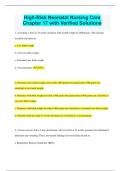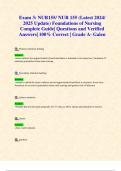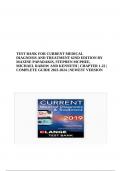Intercostal retractions Study guides, Class notes & Summaries
Looking for the best study guides, study notes and summaries about Intercostal retractions? On this page you'll find 2963 study documents about Intercostal retractions.
Page 4 out of 2.963 results
Sort by

-
NURS 6512 Final Exam Review (Week 7-11)
- Exam (elaborations) • 53 pages • 2024
-
- $20.49
- + learn more
NURS 6512 Final Exam Review (Week 7-11) 1. Examination techniques of the Heart: • Inspection - use tangential lighting; stand to the patient’s right, patient should sit erect and lean forward, lye supine, and left lateral recumbent position; apical pulse midclavicular line 5th left intercostal space; check the skin for cyanosis, venous distention, nail bed for cyanosis and capillary refill time • Palpation - patient supine, palpate the precordium, use proximal halves of the 4 fi...

-
High-Risk Neonatal Nursing Care Chapter 17 with Verified Solutions
- Exam (elaborations) • 24 pages • 2024
- Available in package deal
-
- $9.99
- + learn more
High-Risk Neonatal Nursing Care Chapter 17 with Verified Solutions 1. A neonate is born at 33 weeks' gestation with a birth weight of 2400 grams. This neonate would be classified as: a. Low birth weight b. Very low birth weight c. Extremely low birth weight d. Very premature ANS: a a. Neonates with a birth weight of less than 2500 grams but greater than 1500 grams are classified as low birth weight. b. Neonates with birth weight less than 1500 grams but greater than 1000 grams are...

-
AHA PALS FINAL EXAM 2022|2023 ,100% accurate answers
- Exam (elaborations) • 6 pages • 2023
- Available in package deal
-
- $20.49
- 4x sold
- + learn more
AHA PALS FINAL EXAM 2022|2023 ,100% accurate answers A 12-year-old child being evaluated in the pediatric intensive care unit displays the following ECG waveform. The team interprets this as which arrhythmia? Second degree Second Degree Heart Block (Mobitz II) the picture shown is not the picture in the actual exam Laboratory tests are ordered for a child who has been vomiting for 3 days and is diaphoretic, tachypneic, lethargic and pale. Which test would the provider use to d...

-
Emergency Nursing Pediatric Course (ENPC) TEST with Answers 2022
- Exam (elaborations) • 18 pages • 2022
-
- $15.99
- 1x sold
- + learn more
An unresponsive 2-year-old child was found by his mother with a bottle labeled "Elavil 50 mg" by his side. Which piece of information is important to obtain from his mother? A. The size of the medication bottle. B. The expiration date of the medication. C. The number of pills lef t in the bottle. D. The person for whom the medication was prescribe. A nurse providing crisis intervention to the family of a seriously ill child can best keep the family informed of the child's condition by: ...

-
HESI Exit Exam 2024, Question Bank. 804 Questions and Correct Answers With Rationale. Actual Exam Questions Included. Verified Solution, Guaranteed Acing Of Your Exam.
- Exam (elaborations) • 241 pages • 2024
-
- $25.49
- + learn more
HESI Exit Exam 2024, Question Bank. 804 Questions and Correct Answers With Rationale. Actual Exam Questions Included. Verified Solution, Guaranteed Acing Of Your Exam. What PO2 value indicates respiratory failure in adults? PO2 < 60 mmHg What blood value indicates hypercapnia? PCO2 > 45 mmHg What condition occurs when the PO2 is < 60 mmHg (acute hypoxemia), the CO2 tension rises > 50 mmHg (acute hypercarbia, hypercapnia) & the pH drops < 7.35, or both? Acute respiratory fa...

-
LOW RISK NEONATE TEST
- Exam (elaborations) • 15 pages • 2024
-
- $12.49
- + learn more
<15-16mEq/L -PaCo2 level <40-45mmHg -adequate spontaneous or assisted ventilation -cause of acidosis is being assessed & treated signs of respiratory distress - Answer--tachypnea, retractions, flaring or grunting persist beyond 1 hour after birth -any time severe or worsening tachypnea, retractions, flaring, or grunting develop -any time cyanosis or low SpO2 is present what part of the baby's body should you examine to determine if the baby is cyanotic - Answer-lips a baby, ...

-
NBME - NEW TESTS LATEST UPDATED 2022 QUESTIONS AND ANSWERS
- Exam (elaborations) • 336 pages • 2022
-
- $10.49
- 2x sold
- + learn more
NBME - NEW TESTS LATEST UPDATED 2022 QUESTIONS AND ANSWERS 62 year old woman - osteoporosis - a bisphosphonate is prescribed. The expected beneficial effect of the drug is due to which of the following? Correct Answer-Decreased Osteoclast Activity Cohot Study of elderly women - relative risk ratio for hip fractures among those who exercise regularly is 1.2 (95% confidence interval of 1.1 to 1.8). Which of the following is the conclusion about the effect of exercise on the risk of hip fract...

-
Exam 3: NUR155/ NUR 155 (Latest 2024/ 2025 Update) Foundations of Nursing Complete Guide| Questions and Verified Answers| 100% Correct | Grade A- Galen
- Exam (elaborations) • 67 pages • 2024
- Available in package deal
-
- $11.49
- + learn more
Exam 3: NUR155/ NUR 155 (Latest 2024/ 2025 Update) Foundations of Nursing Complete Guide| Questions and Verified Answers| 100% Correct | Grade A- Galen Q: Primary intention healing: tissue surfaces are approximated (closed) and there is minimal or no tissue loss, formation of minimal granulation tissue and scarring Q: Secondary intention healing Answer: wound in which the tissue surfaces are not approximated and there is extensive tissue loss; formation of excessive granulation ...

-
High-Risk Neonatal Nursing Care, Exam 3 Practice questions with correct answers
- Exam (elaborations) • 48 pages • 2023
- Available in package deal
-
- $16.49
- + learn more
2. A nurse assesses that a 3-day-old neonate who was born at 34 weeks' gestation has abdominal distention and vomiting. These assessment findings are most likely related to: a. Respiratory Distress Syndrome (RDS) b. Bronchopulmonary Dysplasia (BPD) c. Periventricular Hemorrhage (PVH) d. Necrotizing Enterocolitis (NEC) CORRECT ANSWER ANS: d a. Assessment findings for RDS include tachypnea, intercostal retractions, respiratory grunting, and nasal flaring. b. Assessment findings for BPD i...

-
Test Bank for Current Medical Diagnosis and Treatment by Maxine Papadakis, Stephen Mcphee, Michael Rabow & Kenneth Mcquaid |All Chapters, Complete Q & A, Latest|
- Exam (elaborations) • 437 pages • 2023
-
- $32.49
- 1x sold
- + learn more
Which of the following behaviors indicates the highest potential for spreading infections among clients? The nurse: 1) disinfects dirty hands with antibacterial soap. 2) allows alcohol-based rub to dry for 10 seconds. 3) washes hands only after leaving each room. 4) uses cold water for medical asepsis. 2. What is the most frequent cause of the spread of infection among institutionalized patients? 1) Airborne microbes from other patients 2) Contact with contaminated equipment 3) Hands of...

Do you wonder why so many students wear nice clothes, have money to spare and enjoy tons of free time? Well, they sell on Stuvia! Imagine your study notes being downloaded a dozen times for $15 each. Every. Single. Day. Discover all about earning on Stuvia


